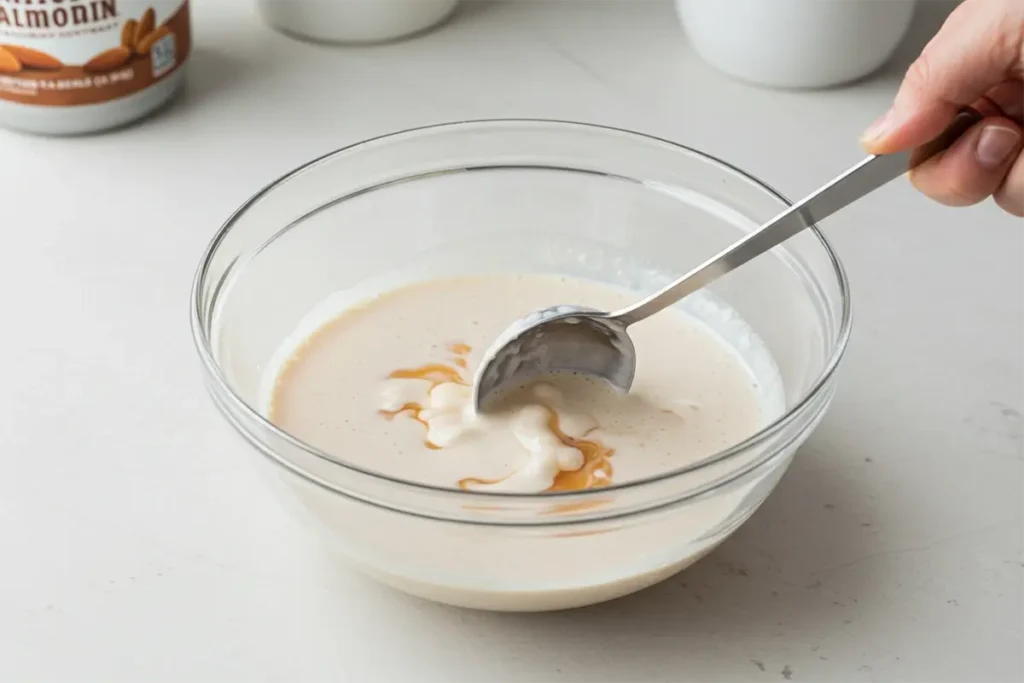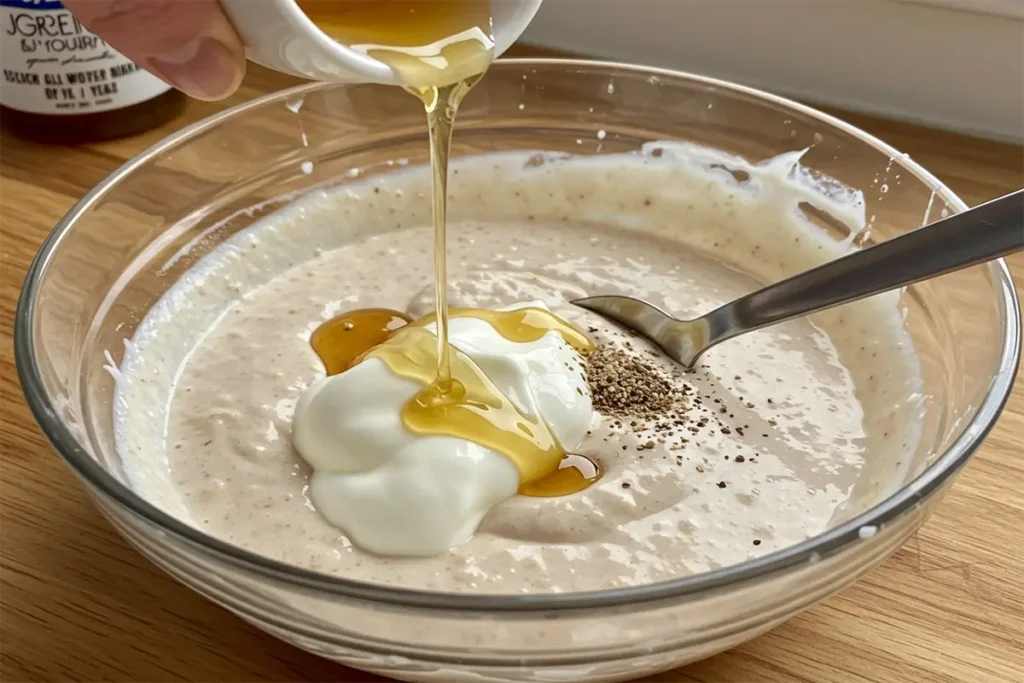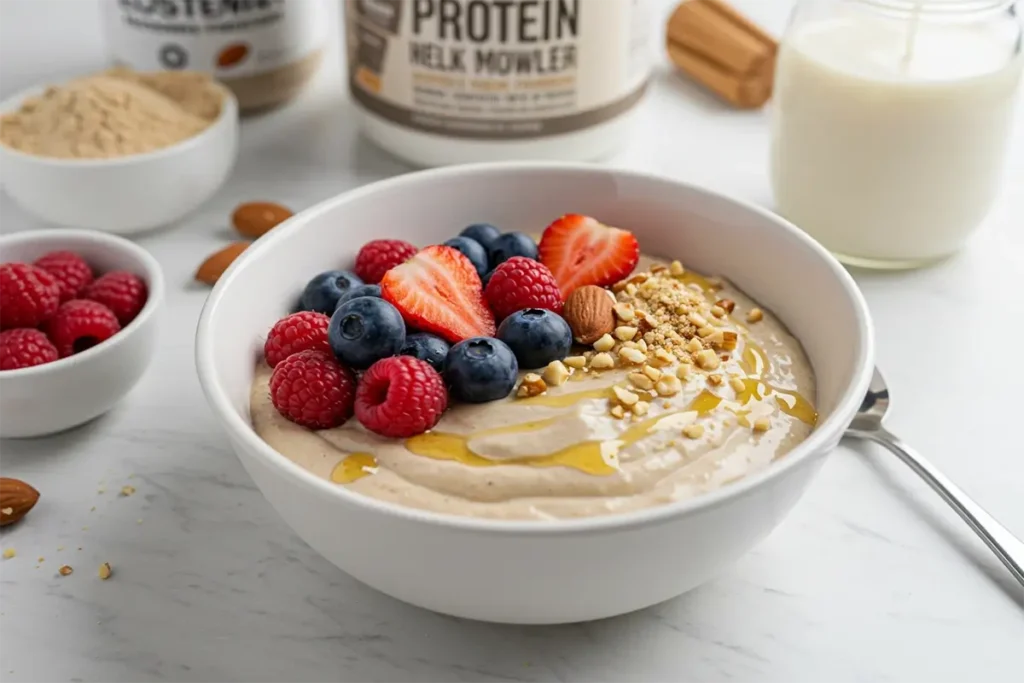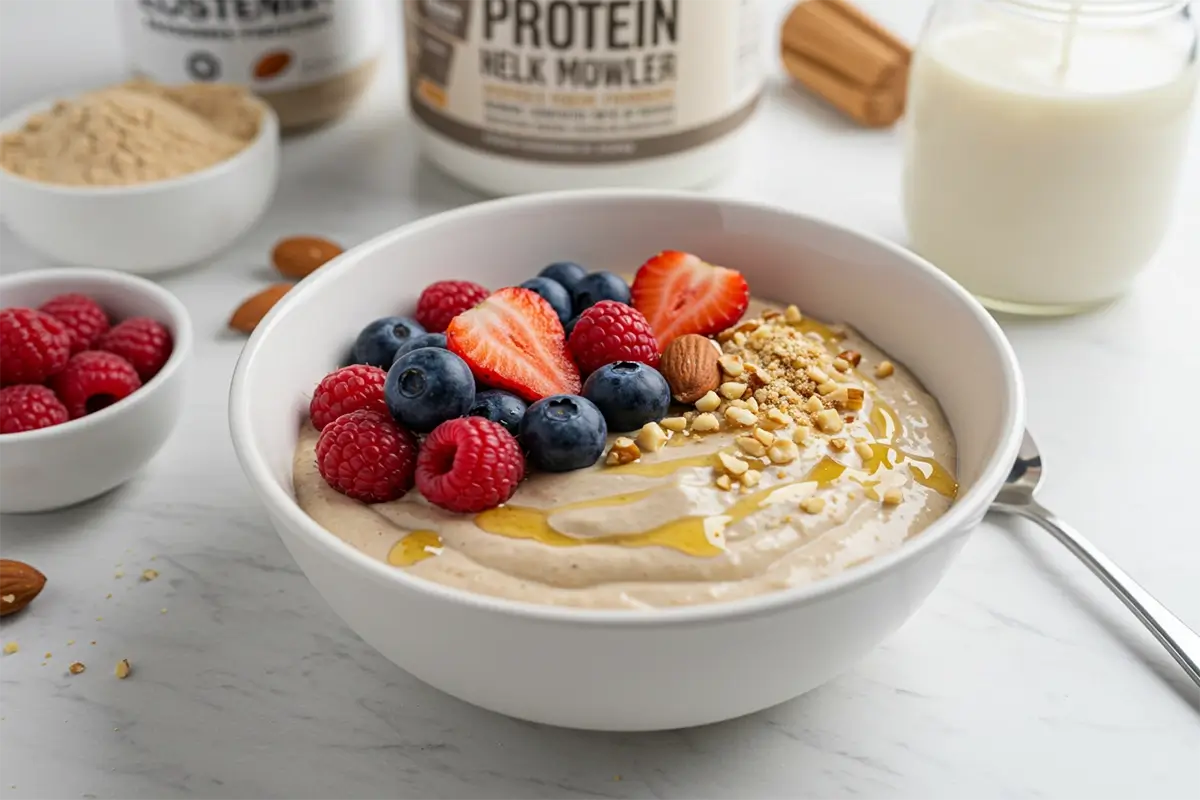If you’re someone who’s ever struggled to get enough protein into your diet or found yourself tired of the same old protein shakes, then protein pudding might be the solution you’ve been looking for. Not only does it offer a creamy, indulgent treat, but it also packs a punch of high-quality protein to support your health and fitness goals. Whether you’re looking to build muscle, lose weight, or simply enjoy a nutritious dessert, protein pudding is here to elevate your snack game. In this article, you’ll discover everything you need to know about this delicious and nutritious treat, including how to make it, its benefits, and why it’s the perfect addition to your daily routine.
Table of Contents
What Is Protein Pudding?
Protein pudding is a smooth, creamy, and nutritious snack or dessert that’s rich in protein. It’s made by mixing protein powder with liquids such as milk (dairy or plant-based) and often enhanced with other ingredients to create a satisfying, flavorful treat. Unlike regular puddings, which are typically high in sugar and low in protein, protein pudding is specifically designed to give you the benefits of a high-protein diet while satisfying your sweet tooth.
While you can purchase ready-made protein puddings from some brands, making your own at home allows you to control the ingredients, customize flavors, and ensure that it fits within your dietary needs. From fitness enthusiasts to those simply looking for healthier snack options, protein pudding provides a convenient, customizable way to boost your protein intake without sacrificing taste.
Why Protein Pudding is the Perfect Snack for Health and Fitness
The Role of Protein in Your Diet
Protein is a crucial nutrient that plays many important roles in your body. It’s essential for muscle repair and growth, especially after exercise, and is involved in virtually every bodily function—from enzyme production to immune defense. Here’s why protein is so important:
- Supports Muscle Growth: If you’re aiming to build muscle, protein is key. After a workout, your muscles need protein to repair themselves and grow stronger.
- Aids in Weight Management: Protein helps you feel fuller for longer, reducing hunger and the likelihood of snacking between meals. This can lead to healthier, more controlled calorie intake.
- Improves Metabolism: Consuming protein can boost your metabolism by increasing the thermic effect of food (TEF), meaning your body burns more calories while digesting protein compared to fats or carbs.
Including protein in every meal, including snacks, is a smart way to stay on top of your fitness goals and support overall health. Protein pudding offers a delicious, easy-to-make option for anyone looking to get more protein in their diet, without relying on traditional protein shakes or bars.
How to Make Protein Pudding: Easy and Delicious Recipes
Making protein pudding at home is a quick and simple process that requires just a few ingredients, and it’s an excellent way to increase your protein intake while satisfying your sweet cravings. Not only does it taste indulgent, but you can easily adjust the recipe to fit your dietary preferences, making it a versatile and customizable treat. Whether you’re looking for a post-workout snack, a healthy dessert, or a quick meal replacement, protein pudding can be tailored to meet your needs.
Basic Protein Pudding Recipe
Here’s a basic recipe to kickstart your protein pudding adventure. It’s the perfect base that you can easily tweak to suit your taste or dietary needs. Let’s get started!
Ingredients Table:
| Ingredient | Amount |
|---|---|
| Protein powder (whey/plant-based) | 1 scoop |
| Unsweetened almond milk | 1 cup |
| Greek yogurt (optional) | 2 tbsp |
| Sweetener (stevia, honey) | to taste |
| Vanilla extract (optional) | 1 tsp |
Instructions:
Combine Protein Powder and Almond Milk:

Start by adding your protein powder and almond milk into a bowl or blender. Stir or blend the ingredients until smooth. This forms the base of your protein pudding, so ensure it’s well-mixed to avoid clumps.
Add Greek Yogurt and Sweetener (Optional):
If you want a creamier texture and a more decadent flavor, add 2 tablespoons of Greek yogurt to the mix. Greek yogurt not only makes the pudding extra smooth, but it also provides additional protein. Add your preferred sweetener (stevia or honey) to taste, depending on how sweet you like your pudding.

Flavor It Up:
For a touch of flavor, stir in vanilla extract or any other flavorings you enjoy. You could add cinnamon, almond extract, or even cocoa powder for a unique twist. This is where you can get creative with the flavor profile of your pudding.
Chill and Set:

Once everything is well-mixed, place the bowl or container in the fridge and let it chill for at least 1 hour. The pudding will set and thicken as it cools, giving you that smooth, indulgent texture.
Serve and Enjoy:
After chilling, your protein pudding is ready to serve. Spoon it into bowls or containers and enjoy! It’s a perfect post-workout snack, a healthy dessert, or a quick and filling breakfast.

Flavor Variations
One of the best things about protein pudding is its versatility. You can easily adapt the basic recipe to fit your flavor preferences, whether you want something rich, fruity, or nutty. Here are a few ideas for flavor variations:
- Chocolate Protein Pudding:
For those who love chocolate, this variation is a must-try! Add a tablespoon of unsweetened cocoa powder to the basic recipe or use a chocolate-flavored protein powder. This will give you a rich, chocolatey pudding without the added sugars typically found in chocolate desserts. - Berry Protein Pudding:
Add a burst of freshness and antioxidants with berries. You can either blend fresh or frozen berries into the pudding mixture or use them as a topping. Blueberries, raspberries, or strawberries work especially well and provide a natural sweetness to the pudding. - Peanut Butter Protein Pudding:
If you’re a peanut butter fan, this is the variation for you. Simply swirl in a tablespoon of peanut butter into the pudding mixture. This not only enhances the flavor with a nutty richness but also adds healthy fats to make the pudding even more filling. - Banana Protein Pudding:
For a sweet, fruity twist, you can blend in a ripe banana with the other ingredients. This adds natural sweetness and makes the pudding even creamier.
Customize Your Protein Pudding
The beauty of protein pudding is that it can be adapted to fit various dietary needs, whether you follow a vegan, dairy-free, gluten-free, or keto diet. Here are some simple swaps and additions to make the pudding work for you:
- Dairy-Free Option: Use plant-based protein powder (like pea, rice, or hemp protein) and substitute almond milk or coconut milk for the dairy-based options.
- Vegan Option: Ensure the protein powder you choose is plant-based, and opt for maple syrup, agave nectar, or stevia as your sweetener.
- Keto-Friendly Option: Use a low-carb protein powder (like whey isolate) and a non-sugar sweetener like erythritol or monk fruit. Skip the Greek yogurt and stick to coconut cream for a richer texture.
By adjusting the ingredients and flavors, you can create a variety of protein puddings that suit any dietary restrictions or cravings you may have.
Final Thoughts
Protein pudding is a simple, versatile, and delicious way to increase your protein intake. Whether you enjoy it after a workout, as a healthy dessert, or as a nutritious snack throughout the day, it’s easy to make and customize. By starting with a basic recipe and adding your favorite flavors, you can create endless variations that satisfy your taste buds and nutritional needs. So, grab your ingredients, get creative with your flavors, and enjoy this protein-packed treat anytime you need a satisfying, healthy option!
Nutritional Advantages of Protein Pudding
You may be curious to know, how does protein pudding benefit your body? Let’s explore the nutritional advantages of this protein-packed dessert in more detail.
Protein Pudding and Muscle Recovery
After a workout, your body requires protein to repair and rebuild muscle tissue. Protein pudding is an excellent post-workout snack, providing the essential nutrients your muscles need to recover. The mix of protein and carbohydrates (especially if you add fruits or natural sweeteners) helps replenish glycogen stores, reduce muscle soreness, and accelerate the recovery process.
- Muscle Repair: The protein in protein pudding aids in repairing muscle fibers after exercise.
- Quick and Easy: Protein pudding is simple to prepare and can be enjoyed immediately after your workout or incorporated into your daily nutrition plan.
Protein Pudding as a Healthy, Low-Calorie Dessert
If weight management is one of your goals, protein pudding can be an excellent option. Unlike traditional desserts such as cakes, cookies, or ice cream, which are often loaded with sugar and unhealthy fats, protein pudding is typically lower in sugar and higher in protein, offering a healthier alternative.
Here’s a comparison of protein pudding versus a typical dessert:
| Dessert Type | Protein Pudding (1 Serving) | Traditional Dessert (1 Serving) |
|---|---|---|
| Calories | ~150-200 | ~350-500 |
| Protein | 20-30g | 2-3g |
| Sugar | Low (if made without added sugar) | High (often 20g+) |
By opting for protein pudding, you’re not just treating yourself to a delicious snack, but you’re also providing your body with a nourishing option that aligns with your fitness goals and supports your overall health.
How Healthy Is Protein Pudding?
Protein pudding is generally a healthy and nutritious option, particularly when made with high-quality ingredients. It is rich in protein, which supports muscle growth, repair, and overall health. Unlike many traditional desserts, protein pudding tends to be lower in sugar and can be customized to fit various dietary needs. Depending on the ingredients you choose, such as using plant-based protein powder or dairy-free milk, protein pudding can fit into many different diets, including vegan, gluten-free, and keto-friendly options.
Additionally, protein pudding provides essential amino acids, especially when made with a complete protein source like whey protein, which supports everything from muscle recovery to immune function. With added ingredients like Greek yogurt, nut butter, or fruits, protein pudding can also provide healthy fats, probiotics, and fiber, making it a balanced snack or dessert.
However, like any food, the healthfulness of protein pudding largely depends on the ingredients you select. Opt for sugar-free or naturally sweetened options to keep it as healthy as possible, and be mindful of portion sizes to ensure it fits into your daily nutritional goals.
Can I Use a Protein Shake Instead of Milk for Protein Pudding?
Yes, you can use a protein shake in place of milk to make protein pudding. This substitution will increase the protein content of your pudding and may provide additional flavors depending on the protein powder used in the shake. If you are using a protein shake with a flavor, such as chocolate or vanilla, it can add extra depth and taste to your pudding without the need for other flavoring agents.
However, there are a few things to consider:
- Consistency: A protein shake may be more liquid than regular milk, so you may need to adjust the amount of thickening agents like Greek yogurt, chia seeds, or even a small amount of cornstarch to maintain a creamy pudding consistency.
- Taste: The taste of your pudding will be influenced by the flavor of the protein shake. If you prefer a specific flavor profile, choose a shake that aligns with your desired outcome.
Using a protein shake can be a convenient and effective way to boost the protein content of your pudding while also streamlining the preparation process, especially if you’re already consuming protein shakes as part of your daily routine.
What Is Protein Pudding Made Of?
Protein pudding is made primarily from protein powder, which serves as the main source of protein. The other ingredients in protein pudding typically include a liquid base (like almond milk, coconut milk, or even a protein shake), a thickening agent for the creamy texture (such as Greek yogurt, chia seeds, or gelatin), and optional flavoring agents like vanilla extract, cocoa powder, or sweeteners (such as honey or stevia).
The recipe can be easily customized based on dietary preferences. For example:
- Plant-based protein powder for vegan or dairy-free options.
- Almond or oat milk for dairy-free, low-calorie, and lactose-intolerant-friendly versions.
- Greek yogurt for extra protein and creaminess, or coconut cream for a dairy-free alternative.
- Natural sweeteners like stevia or monk fruit to keep the dessert low in sugar.
The beauty of protein pudding is its flexibility—you can experiment with different ingredients and flavors to create a version that meets your specific nutritional needs and taste preferences.
Why Does My Stomach Hurt After Protein Pudding?
If you experience stomach discomfort after eating protein pudding, there could be several reasons behind it. Here are a few possible causes:
- Lactose Intolerance: If you used dairy-based milk or Greek yogurt and you’re lactose intolerant, your stomach may react to the lactose, causing discomfort, bloating, or even diarrhea. To avoid this, try using lactose-free milk or plant-based alternatives like almond or oat milk.
- High Protein Intake: Consuming too much protein at once can lead to digestive issues, especially if your body isn’t accustomed to high-protein foods. It can cause bloating, gas, or cramping. Make sure to consume protein pudding in moderation and spread your protein intake evenly throughout the day.
- Sweeteners: Some artificial sweeteners, like sorbitol or erythritol, used in sugar-free or low-calorie recipes, can cause digestive issues such as bloating or gas. If you’re sensitive to these sweeteners, opt for natural alternatives like stevia or monk fruit.
- Fiber Content: If you’ve added ingredients like chia seeds or fruits to your pudding, the high fiber content could be causing discomfort. Fiber is great for digestion but can lead to bloating and gas if consumed in large amounts, especially if you’re not used to it.
If the discomfort persists, consider adjusting the ingredients or consulting a healthcare provider to determine the specific cause of the pain. Adjusting your portion size or ingredient choices can often solve these issues.
Frequently Asked Questions (FAQ)
Can Protein Pudding Help Build Muscle?
Yes! Protein pudding is an excellent source of protein, which is essential for muscle repair and growth. By eating protein pudding after workouts, you can support your muscle-building efforts while enjoying a satisfying snack.
Can I Make Protein Pudding Dairy-Free?
Absolutely! If you’re lactose intolerant or prefer plant-based options, simply use plant-based protein powder (such as pea or hemp protein) and swap out dairy milk for almond, oat, or coconut milk. You’ll still get the same delicious and nutritious benefits.
How Much Protein Should I Include in My Pudding?
Typically, 1 scoop of protein powder provides around 20-30 grams of protein, which is a good amount for a single serving of protein pudding. However, your protein needs may vary based on your individual goals, so feel free to adjust the amount to suit your dietary requirements.
Is Protein Pudding Good for Weight Loss?
Yes! Protein pudding can be a great part of a weight loss strategy. Protein helps keep you full for longer, reducing hunger and helping to control your calorie intake. As a healthy, low-calorie snack or dessert, protein pudding can fit perfectly into a weight loss plan.
Conclusion
Protein pudding is more than just a healthy snack—it’s a delicious, versatile, and easy-to-make treat that can satisfy your cravings while helping you reach your fitness and health goals. Whether you’re aiming to build muscle, lose weight, or simply want a nutritious dessert, protein pudding checks all the boxes. It’s time to ditch the boring, sugary snacks and start incorporating protein pudding into your daily routine. So go ahead, try out the recipes, experiment with flavors, and enjoy the benefits of this protein-packed treat. Your body (and taste buds) will thank you!

